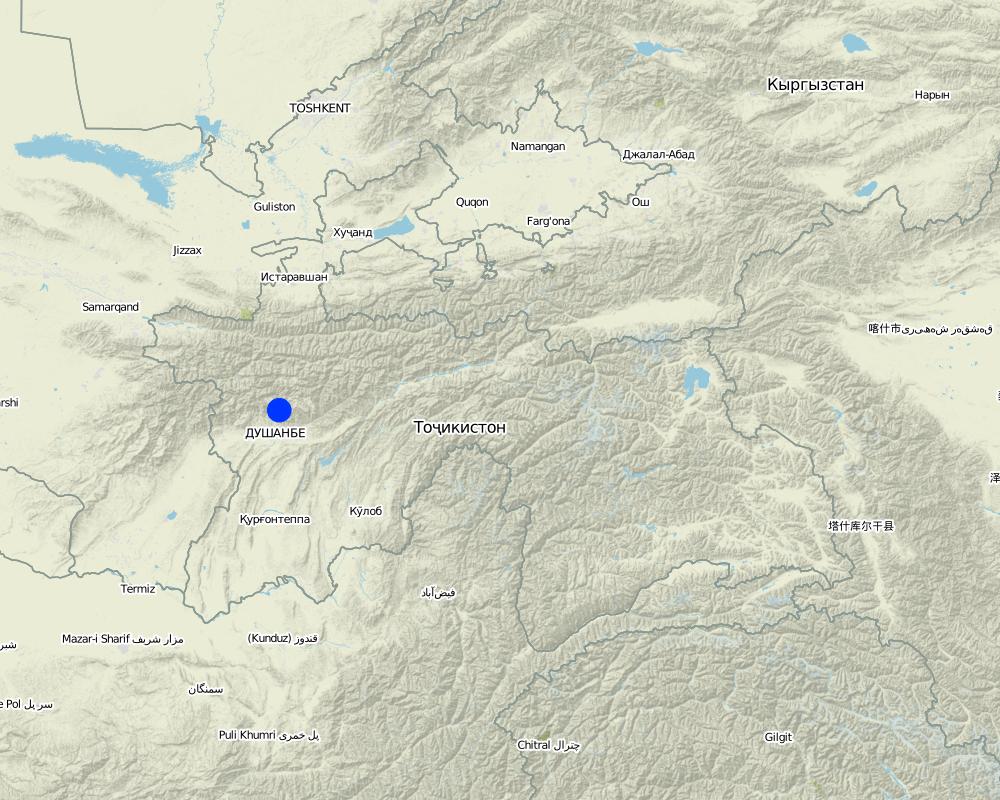Voluntary Labour Assistance [塔吉克斯坦]
- 创建:
- 更新:
- 编制者: Erik Bühlmann
- 编辑者: –
- 审查者: David Streiff
approaches_2643 - 塔吉克斯坦
查看章节
全部展开 全部收起1. 一般信息
1.2 参与方法评估和文件编制的资源人员和机构的联系方式
有助于对方法进行记录/评估的机构名称(如相关)
NCCR North-South (NCCR North-South) - 吉尔吉斯斯坦1.3 关于使用通过WOCAT记录的数据的条件
编制者和关键资源人员接受有关使用通过WOCAT记录数据的条件。:
是
1.4 SLM技术问卷的参考
2. SLM方法的描述
2.1 该方法的简要说明
Voluntary labour assistance for labour intensive activities whereby community members help each other in contributing labour on the basis of mutual understanding.
2.2 该方法的详细说明
该方法的详细说明:
Aims / objectives: Members of the labour exchange group (often relatives and neighbours) can ask for assistance when labour intensive farm activities need to be performed. A farmer asks fellow land users individually for support. The request is made one or two weeks beforehand, informing individual farmers about the programme. During these informal land user exchanges, farmers share experiences and technical know-how on soil-and water conservation technologies and discuss details of the planned work. On the specified date, participants equip themselves with all necessary farm implements required for the activity. The farmer who seeks assistance should host the participants and prepare food and drinks. The objective of the approach is to alleviate labour shortages and to strengthen the relationship between community members.
2.5 采用该方法的国家/地区/地点
国家:
塔吉克斯坦
区域/州/省:
RRS
有关地点的进一步说明:
Faizabad
Map
×2.7 方法的类型
- 传统/本土
2.8 该方法的主要目的/目标
The Approach focused mainly on SLM with other activities (approach is used for all labour intensive activities, such as construction work, establishment of SWC technologies, harvesting etc.)
To overcome labour constraints.
The SLM Approach addressed the following problems: shortage of work force, since most farmers send their sons (or go themselves) to Russia to earn money.
2.9 推动或妨碍实施本办法所适用的技术的条件
财务资源和服务的可用性/可得性
- 阻碍
Lack of finance to hire labour
Treatment through the SLM Approach: mutual voluntary labour assistance is independent from the financial situation of land users
法律框架(土地使用权、土地和水使用权)
- 阻碍
The existing land ownership, land use rights / water rights moderately hindered the approach implementation Presently, all land in Faizabad Rayon is rented from the state. Farmers are often not willing to implement labour intensive SWC technologies if they do not own the land they farm.
其他
- 阻碍
Lack of able work force since many male villagers left to work in Russia.
Treatment through the SLM Approach: gathering of available work force to carry out labour intensive farming activities.
3. 相关利益相关者的参与和角色
3.1 该方法涉及的利益相关者及其职责
- 当地土地使用者/当地社区
Whilst decision making, planning and implementation of SWC technologies is mainly carried out by men, women assist mainly only for harvesting activities.
3.2 当地土地使用者/当地社区参与该方法的不同阶段
| 当地土地使用者/当地社区的参与 | 指定参与人员并描述活动 | |
|---|---|---|
| 启动/动机 | 自我动员 | |
| 计划 | 自我动员 | work is planned with advice of friends and elderly members |
| 实施 | 自我动员 | |
| 监测/评估 | 无 | |
| Research | 无 |
3.4 有关SLM技术选择的决策
具体说明谁有权决定选择要实施的技术:
- 仅限土地使用者(自主)
解释:
Decisions on the method of implementing the SLM Technology were made by by land users* alone (self-initiative / bottom-up)
4. 技术支持、能力建设和知识管理
4.1 能力建设/培训
是否为土地使用者/其他利益相关者提供培训?:
否
4.2 咨询服务
土地使用者有权使用咨询服务吗?:
是
指明是否提供了咨询服务:
- 在土地使用者的土地上
说明/注释:
Name of method used for advisory service: Informal land user extensions
Advisory service is quite adequate to ensure the continuation of land conservation activities
4.3 机构强化(组织发展)
是否通过这种方法建立或加强了机构?:
- 否
4.4 监测和评估
监测和评估是该方法的一部分吗?:
是
注释:
Economic / production aspects were ad hoc monitored by 0 through measurements; indicators: None
Area treated aspects were ad hoc monitored by 0 through observations; indicators: None
There were no changes in the Approach as a result of monitoring and evaluation: None
4.5 研究
研究是该方法的一部分吗?
否
5. 融资和外部物质支持
5.1 该方法中SLM组成部分的年度预算
如果不知道准确的年度预算,请给出一个范围:
- < 2,000
注释(例如主要的资助来源/主要捐助者):
Approach costs were met by the following donors: other (land user requesting for assistance): 100.0%
5.3 对特定投入的补贴(包括劳动力)
如果土地使用者的劳动力是一项重要的投入,那么是不是:
- 自愿
注释:
The provision of food for voluntary assistance workers should be seen more as a part of traditional hospitality, rather than a food for work payment.
5.4 信用
是否根据SLM活动的方法给予信用值?:
否
5.5 其它激励或手段
是否有其他激励措施或工具用于促进SLM技术的实施?:
否
6. 影响分析和结论性陈述
6.1 方法的影响
该方法是否帮助土地使用者实施和维护SLM技术?:
- 否
- 是,很少
- 是,中等
- 是,支持力度很大
Through the approach, land users shared skills and knowledge, but could benefit from experiences of other farmers before establishment of an SWC technology.
该方法是否改善了阻碍SLM技术实施的土地使用权/用户权问题?:
- 否
- 是,很少
- 是,中等
- 是,支持力度很大
The approach eases the problem of labour shortages; the decision to implement substantial SWC technologies is still taken by the individual land user and his family. The problem is likely to be overcome in the near future. Awareness of land users about soil and water conservation can be increased through offering workshops and seminars. Improved SWC knowledge may lead to more sustainable land management through implementation of SWC technologies. However, in order to make fa..............
Did other land users / projects adopt the Approach?
- 否
- 是,很少
- 是,中等
- 是,支持力度很大
The approach has evolved and developed within a Tajik rural community. Labour assistance can be requested by any farmer who is willing to help others as well.
6.3 方法活动的可持续性
土地使用者能否维持通过该方法实施的措施(无外部支持的情况下)?:
- 是
6.4 该方法的长处/优点
| 土地使用者眼中的长处/优势/机会 |
|---|
| Eases the labour problem with very little costs. |
| 编制者或其他关键资源人员认为的长处/优势/机会 |
|---|
| Experiences and knowledge are shared. |
| Stronger social relationships among community members. |
| SWC technologies can be implemented more easily |
| Eases labour shortages. (How to sustain/ enhance this strength: The approach is sustainable in itself, as long as the approach is based on a mutual understanding.) |
| Farming activities can be carried out according to their seasonal calendar. |
6.5 该方法的弱点/缺点以及克服它们的方法
| 土地使用者认为的弱点/缺点/风险 | 如何克服它们? |
|---|---|
| When assisting others, sometimes their own work cannot be carried out on time. |
| 编制者或其他关键资源人员认为的弱点/缺点/风险 | 如何克服它们? |
|---|---|
| If no means are available to host participants, farmers cannot request assistance. | |
| Only those farmers who have sufficient means to support other can participate in the approach. |
链接和模块
全部展开 全部收起链接
无链接
模块
无模块


